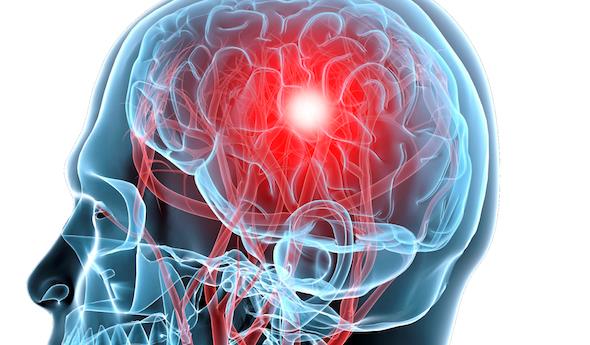
2017-18 Report Shows Fewer Concussions
August 8, 2018
By Geoff Kimmerly
Second Half editor
Concussions are down, according to data compiled by the Michigan High School Athletic Association during its third year of collecting head injury reports from member high schools.
The work is not done – but this year’s data reinforces trends that emerged during the first two years of reporting and will assist the MHSAA as it explores solutions to continue reducing the incidence of head injuries in school sports.
The 2017-18 concussion report found a 9.6-percent decrease in the number of confirmed concussions from the previous year. Student-athletes at MHSAA member high schools encountered during 2017-18 a total of 3,580 head injuries – or 4.8 per member school, compared to the 2016-17 average of 5.2. Total participation in MHSAA sports for 2017-18 was 284,920 – with students counted once for each sport he or she played – and only 1.3 percent of participants experienced a head injury, down from 1.4 in 2016-17 and 1.6 percent the first year of the study.
As first mandated in 2015-16, member schools are required to report head injuries to the MHSAA identifying the sport that each student-athlete was participating in and whether the injury was sustained during practice or competition. Schools also are required to designate at which level – varsity, junior varsity or freshman – the injury occurred.
The full report of all head injuries experienced during 2017-18 by student-athletes at MHSAA member high schools – including percentages by sport (per 1,000 participants), gender and team level, as well as data tracking when athletes returned to play – is available by clicking here.
Consistent with the first two years of the study, the MHSAA received data from more than 99 percent of its member high schools after the fall, winter and spring seasons and continued to track each injury report through its conclusion this summer. Member junior high and middle schools also were allowed, although not mandated, to report their potential head injuries; and those findings are not part of the published report.
The decrease in overall head injury reports collected for 2017-18 follows a similar reduction from 2015-16 to 2016-17 – and brings the total decrease to 19.6 percent fewer reports since the first year of the study.
MHSAA Executive Director John E. “Jack” Roberts noted that the decreases in reports, both year to year and since the first year of the survey, likely have some relation to year-to-year fluctuation, refinement of the follow-up reporting process and a better understanding by schools of what is not to be included for the survey – including head injuries not diagnosed as concussions and head injuries that did not take place during MHSAA-sponsored activities.
However, the findings of this year’s study – and their similarities to the findings from the first two surveys – has begun to clarify the identification and understanding of trends. Continuing to emerge perhaps most prominently is the higher incidence of concussion reports from girls sports – and pertinent questions about physiological and social causes behind those results.
“With three years of reporting by virtually 100 percent of our high schools, what we’re learning is no longer anecdotal; the results are beginning to identify valid trends and genuine issues that need to be addressed,” Roberts said. “For example, it’s even clearer than before that girls are reporting three times the number of concussions as boys when comparing similar sports – soccer, basketball and baseball versus softball. As a result, we’ve already begun to incorporate these gender differences into our coaches education, and the writers of high school playing rules are obligated to focus on these gender differences as well.”
Although the total number of confirmed concussions was significantly lower again in 2017-18, a number of findings detailing those injuries fell in line with results of the first two surveys.
Boys experienced 2,373– or 66 percent – of those injuries, the same ratio as 2016-17, and not surprisingly as boys have a much higher participation in contact sports. More than half of head injuries – 56 percent – were experienced by varsity athletes, which for the second year also fell within a percent difference of the previous year’s findings.
A total of 2,330 head injuries – or 65 percent – came in competition as opposed to practice. More than half took place during either the middle of practice or middle of competition as opposed to the start or end, and 52 percent of injuries were a result of person-to-person contact. The MHSAA also asked schools to report the number of days between the head injury and the athlete’s return to activity – and the two largest groups, both at 24 percent, returned to activity after either 6 to 10 days of rest or 11 to 15. All of these findings were within 1-3 percent of those discovered from the 2016-17 data.
Contact sports again revealed the most head injuries. Ranking first was football, 11 and 8-player combined, with 41 head injuries per 1,000 participants – a decrease for the second straight year, this time from 44 head injuries per 1,000 participants in 2016-17 and down from 49 head injuries per 1,000 football participants shown by the first study in 2015-16.
Ice hockey repeated with the second-most injuries per 1,000, with 32 (down from 36 injuries per 1,000 from 2016-17 and 38 per 1,000 in 2015-16), and girls soccer and wrestling tied for third with 25 head injuries per 1,000 participants – girls soccer down from 28 head injuries per 1,000 participants and wrestling down from 26 per 1,000 in 2016-17.
Also consistent with 2016-17, the next five sports (after football and hockey) to show the highest incidences of head injuries were girls sports – girls soccer followed by girls basketball (22 per 1,000), girls competitive cheer (20) and girls lacrosse (20). Boys lacrosse (17), girls gymnastics (16) and boys soccer (12) were the only other sports to show double-digit head injuries per 1,000 participants.
Females again reported significantly more concussions than males playing the same or similar sports – soccer, basketball and baseball/softball. Female soccer players reported more than double the concussions per 1,000 participants as male soccer players (25 to 12), while female basketball players also reported more than double the number of concussions per 1,000 participants (22 to 9). Softball players reported seven concussions per 1,000 participants, and baseball players reported three per 1,000. Although the percentage differences vary from year to year, the results of all three comparisons remained consistent with what the survey found in 2015-16 and 2016-17.
The MHSAA in 2018-19 is directing its sport committees to focus on a pair of questions – how to increase participation and how to make their specific sports safer – the latter aiming to put some of what has been learned from concussion reporting into practice. The MHSAA also is continuing to invite Michigan’s universities, health care systems and the National Federation of State High School Associations (NFHS) to take part in analyzing the data and resulting questions that have arisen during the past three years.
“Regrettably, I do not see a nationwide head injury reporting effort likely,” Roberts said. “First, it’s hard to coordinate 50 states’ efforts. And second, if left to medical professionals, the survey tool might become so cumbersome that schools would be reluctant to participate – and certainly, it would not get the 99.9 percent cooperation that we’ve enjoyed from schools over these three years.”
Schools report possible concussions online via the MHSAA Website. Reports are then examined by members of the MHSAA staff, who follow up with school administrators as those student-athletes continue to receive care and eventually return to play. Student privacy is protected.
The reporting of possible concussions is part of a three-pronged advance by the MHSAA in concussion care begun during the 2015-16 school year. The MHSAA completed in spring 2017 the largest-ever state high school association sideline concussion testing pilot program, with a sample of schools from across the state over two years using one of two screening tests designed to detect concussions. The MHSAA also was the first state association to provide all participants at every member high school and junior high/middle school with insurance intended to pay accident medical expense benefits – covering deductibles and co-pays left unpaid by other policies – resulting from head injuries sustained during school practices or competitions and at no cost to either schools or families.
Previously, the MHSAA also was among the first state associations to adopt a return-to-play protocol that keeps an athlete out of activity until at least the next day after a suspected concussion, and allows that athlete to return to play only after he or she has been cleared unconditionally for activity by a doctor (M.D. or D.O.), physician’s assistant or nurse practitioner.
In addition, the MHSAA’s Coaches Advancement Program – which includes courses that must be completed by all varsity head coaches hired for the first time at a member school – provides substantial instruction on concussion care. Separately, rules meetings that are required viewing for high school varsity and subvarsity head and assistant coaches at the start of each season include detailed training on caring for athletes with possible head injuries.

Detroit PSL’s McEvans, Comstock’s Ansel & KLAA’s Masi Named 2024 Bush Award Recipients
By
Geoff Kimmerly
MHSAA.com senior editor
July 23, 2024
Detroit Public School League assistant director Anika McEvans, Comstock Public Schools athletic director Justin Ansel and Kensington Lakes Activities Association commissioner Bryan Masi all have served educational athletics for multiple decades in high-profile positions – but as is common in those roles, with much of their difference-making work taking place behind the scenes.
To recognize their efforts and celebrate those vast contributions to school sports, they have been named the 2024 recipients of the Michigan High School Athletic Association’s Allen W. Bush Award.
Al Bush served as executive director of the MHSAA for 10 years. The award honors individuals for past and continuing service to school athletics as a coach, administrator, official, trainer, doctor or member of the media. The award was developed to bring recognition to people who are giving and serving locally, regionally or statewide without a lot of attention. This is the 33rd year of the award.
McEvans finished her fifth school year this spring serving in the Office of Athletics for the Detroit Public Schools Community District, which administers programs for the Detroit PSL. She is responsible for planning and implementation of the PSL’s sports offerings for 72 elementary and middle schools in addition to her several responsibilities supporting the league’s 20 high schools.
 The 1994 Detroit Renaissance graduate, and three-sport athlete there, came to the PSL from Southfield Public Schools, where she served as athletic director from 2012-15 for the former Southfield High School and then as district athletic director through 2017-18. As district director, she supervised more than 100 coaches, staff and volunteers and assisted in the merger of Southfield High and Southfield-Lathrup into Southfield Arts & Technology High School for the start of the 2016-17 school year. She previously served as well in several roles at Detroit Academy of Arts & Sciences from 2006-12, and also as director of business operations and then general manager for the Detroit Demolition/Detroit Danger women’s professional football franchise from 2002-06 and as assistant general manager for the Motor City Mechanics minor league hockey team from 2004-06.
The 1994 Detroit Renaissance graduate, and three-sport athlete there, came to the PSL from Southfield Public Schools, where she served as athletic director from 2012-15 for the former Southfield High School and then as district athletic director through 2017-18. As district director, she supervised more than 100 coaches, staff and volunteers and assisted in the merger of Southfield High and Southfield-Lathrup into Southfield Arts & Technology High School for the start of the 2016-17 school year. She previously served as well in several roles at Detroit Academy of Arts & Sciences from 2006-12, and also as director of business operations and then general manager for the Detroit Demolition/Detroit Danger women’s professional football franchise from 2002-06 and as assistant general manager for the Motor City Mechanics minor league hockey team from 2004-06.
McEvans has provided valuable input on a variety of MHSAA committees over the last decade, including athletic equity, junior high/middle school, scholar-athlete and as part of multiple officials and site selection committees and as a key voice on the MHSAA Multi-Sport Task Force during the last half of the last decade. The mother of three – with two current college athletes and a college freshman-to-be – also served as head girls basketball coach at Academy of Arts & Sciences, assistant girls basketball coach at Southfield and assistant boys basketball coach and assistant softball coach at Renaissance. She has a bachelor’s degree in sports management & communication from University of Michigan and a master’s in business administration from University of Detroit Mercy.
“Anika McEvans has provided a valuable voice in a variety of subjects of statewide importance, but especially on topics impacting students as they transition from middle school to high school – relying not only on her experiences as an administrator, but also as a parent helping her children navigate their paths in athletics,” MHSAA Executive Director Mark Uyl said. “Her work on the Junior High/Middle School Committee and Multi-Sport Task Force directly led to the creation of more opportunities for our younger athletes, but with a continuing focus on providing them with a well-rounded athletic experience.”
Ansel has served the last 17 years as athletic director for Comstock Public Schools, and during his time in the district also has coached varsity girls basketball and boys soccer and middle school girls and boys basketball, soccer and cross country. Both of his Colts varsity programs won multiple league championships under his guidance. Ansel came to Comstock after a decade at Onaway, where he taught and coached all 10 years and also served as athletic director over the final five.
 His vast experiences on the sidelines and in the athletic office have made Ansel a valuable contributor on several MHSAA committees as well, including most recently the Junior High/Middle School Committee, and he’s also served as Southwest 10 Conference president and in multiple leadership roles with the Michigan Interscholastic Athletic Administrators Association (MIAAA). Locally, Ansel has raised from than $60,000 for various projects at Comstock, several highlighting the school’s athletic history.
His vast experiences on the sidelines and in the athletic office have made Ansel a valuable contributor on several MHSAA committees as well, including most recently the Junior High/Middle School Committee, and he’s also served as Southwest 10 Conference president and in multiple leadership roles with the Michigan Interscholastic Athletic Administrators Association (MIAAA). Locally, Ansel has raised from than $60,000 for various projects at Comstock, several highlighting the school’s athletic history.
A Monroe High graduate, Ansel earned a bachelor’s degree from Spring Arbor University in 1997, master’s degrees in education from Marygrove College in 2003 and educational leadership from Grand Valley State University in 2005, and he completed GVSU’s educational specialist in leadership program in 2018. He also has earned his certified master athletic administrator designation from the National Interscholastic Athletic Administrators Association (NIAAA) and completed the master elite level of the MHSAA Coaches Advancement Program (CAP). Ansel was nominated by the MIAAA for the NIAAA’s Jim Teff Professional Development Achievement Award in 2019, and he was named the MIAAA’s Region 4 Athletic Director of the Year in 2023.
“Justin Ansel is known in his community, league and by those who have served with him across the state for his hands-on approach to providing enriching experiences for the communities he serves,” Uyl said. “His style as an administrator reflects what he’s provided as a coach – he’s known as an insightful team builder always working to move his programs forward.”
Masi just completed his fourth year as commissioner of the Kensington Lakes Activities Association, which is made up of 16 of the largest suburban schools in Metro Detroit, with his responsibilities including serving as liaison for the league locally and at the state level. He also previously served as the KLAA’s football commissioner from the league’s start in 2008.
 He previously served as athletic director at Northville for 17 years, where he created the Northville Athletic Community Service Initiative that has raised thousands of dollars and provided goods and services for needy individuals and community service groups. He also started Northville’s unified sports program and hosted one of the MHSAA’s first junior high/middle school cross country Regional meets during the pilot stage of that program. Northville also hosted several MHSAA postseason events and sessions of the Coaches Advancement Program under his leadership.
He previously served as athletic director at Northville for 17 years, where he created the Northville Athletic Community Service Initiative that has raised thousands of dollars and provided goods and services for needy individuals and community service groups. He also started Northville’s unified sports program and hosted one of the MHSAA’s first junior high/middle school cross country Regional meets during the pilot stage of that program. Northville also hosted several MHSAA postseason events and sessions of the Coaches Advancement Program under his leadership.
A teacher previously and longtime coach as well, Masi was named Michigan Secondary Teacher of the Year in 1997 by the Michigan Association for Health, Physical Education, Recreation and Dance (MAPHERD) and selected to coach in the Michigan High School Football Coaches Association East/West All-Star Game in 1998. He was named MIAAA Region 11 Athletic Director of the Year in 2013 and MIAAA Middle School Athletic Director of the Year in 2019, and inducted into the Northville Athletic Hall of Fame in 2021. Masi also has served on several MHSAA committees including for football, gymnastics and junior high/middle school sports.
Masi graduated from Dearborn Edsel Ford, then earned his bachelor’s degree from Western Michigan University, his master’s from Wayne State University and his certified athletic administrator (CAA) designation.
“Bryan Masi has brought the leadership, perspective and ingenuity he employed to build Northville’s success to the KLAA, and those qualities continue to show as he leads one of the state’s most high-profile leagues,” Uyl said. “Bryan is admired and respected by his counterparts, locally and across the state, not only for how he leads but the values he promotes in doing so.”

